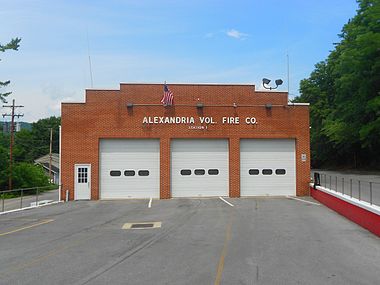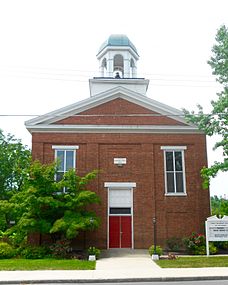Alexandria, Pennsylvania
Alexandria, Pennsylvania | |
|---|---|
Borough | |
814 | |
| FIPS code | 42-00756 |
Alexandria is a borough in Huntingdon County, Pennsylvania, United States. The population was 388 at the 2020 census.[3]
Geography
According to the United States Census Bureau, the borough has a total area of 0.1 square miles (0.3 km2), all land.
Demographics
| Census | Pop. | Note | %± |
|---|---|---|---|
| 1800 | 138 | — | |
| 1810 | 156 | 13.0% | |
| 1820 | 280 | 79.5% | |
| 1840 | 575 | — | |
| 1850 | 601 | 4.5% | |
| 1860 | 534 | −11.1% | |
| 1870 | 556 | 4.1% | |
| 1880 | 484 | −12.9% | |
| 1890 | 438 | −9.5% | |
| 1900 | 406 | −7.3% | |
| 1910 | 432 | 6.4% | |
| 1920 | 440 | 1.9% | |
| 1930 | 443 | 0.7% | |
| 1940 | 442 | −0.2% | |
| 1950 | 443 | 0.2% | |
| 1960 | 381 | −14.0% | |
| 1970 | 495 | 29.9% | |
| 1980 | 435 | −12.1% | |
| 1990 | 420 | −3.4% | |
| 2000 | 408 | −2.9% | |
| 2010 | 349 | −14.5% | |
| 2020 | 388 | 11.2% | |
| 2021 (est.) | 384 | [3] | −1.0% |
| Sources:[4][5][6][2] | |||
As of the
There were 139 households, out of which 32.4% had children under the age of 18 living with them, 47.0% were married couples living together, 16.1% had a female householder with no husband present, and 28.2% were non-families. 25.5% of all households were made up of individuals, and 10.7% had someone living alone who was 65 years of age or older. The average household size was 2.58 and the average family size was 3.00.
In the borough the population was spread out, with 23.1% under the age of 18, 2.3% from 18 to 19, 4.9% from 20 to 24, 13.9% from 25 to 34, 21.4% from 35 to 49, 19.9% from 50-64, and 14.5% who were 65 years of age or older. The median age was 37 years. The population was 49.42% male, and 50.58% female.
History
The year 1744 is the first record of John Hart's “logg”, near where Alexandria is located now. During the land purchase of 1755 James Sterrat of Carlisle purchased 400 acres including the sleeping place called John Hart's log on the Juniata River, which is now Alexandria.
Some time in the years before 1785 the first mention of a religious group called Hartslog Presbyterian Congregation was formed. A log worship house, Old Hartslog Church, stood upon the hill one mile (1.6 km) north of the present site of the town of Alexandria, where a burial ground was later made. This was a primitive structure but by 1787 a floor was laid, six large windows set in, a large door constructed, and a pulpit and a communion table made. In 1794 it was laid off into four sections, and fitted with pews. In 1826, the old Hartslog congregation moved to a brick building, referred to by Senator John Scott in his memoirs as the "Brick Church", which seems to have been located near to the site of the present Reformed Church. The old log worship house was taken down the same year, and some of its logs were used in one or two of the dwellings of Alexandria.
In the late 18th century the primary transportation to and from Alexandria was the
-
Old railway station
Hartslog Heritage Day Festival
Alexandria hosts the annual "Hartslog Heritage Day" celebration each year on the second Saturday of October. The day-long event recognizes the early days of the small borough, when, in 1744, a licensed Indian trader named John Hart used a large hollowed-out log to feed and salt his horses while he conducted his trading.
Early settlers used this log as a landmark to describe the location of their claims and referred to this area as Hartslog Settlement. In 1793 this area was laid out into town lots and named Alexandria, with the street near the site of the log name Hartslog Street.
Today the name remains for Hartslog Street as well as the region — "Hartslog Valley."
The Hartslog Museum located on the second floor of the library in Alexandria is open one weekend a month and on Hartslog Day. The museum includes artifacts and antiques from the area, when Pennsylvania was still inhabited by Indian tribes.
Hartslog Day helps to support the museum.
-
Fire Department
-
Christ Reformed Church
-
Old hotel on Main Street
Notable people
- Rev. Pledge of Allegiance.
- Agnes Irvine Scott – Agnes ScottCollege is named for her.
- U.S. House of Representatives
- John Scott, Jr. – Member of the United States Senate
References
- ^ "ArcGIS REST Services Directory". United States Census Bureau. Retrieved October 12, 2022.
- ^ a b "Census Population API". United States Census Bureau. Retrieved Oct 12, 2022.
- ^ a b Bureau, US Census. "City and Town Population Totals: 2020—2021". Census.gov. US Census Bureau. Retrieved August 11, 2022.
- ^ "Census of Population and Housing: Decennial Censuses". United States Census Bureau. Retrieved 2012-03-04.
- ^ "Incorporated Places and Minor Civil Divisions Datasets: Subcounty Resident Population Estimates: April 1, 2010 to July 1, 2012". Population Estimates. U.S. Census Bureau. Archived from the original on 11 June 2013. Retrieved 11 December 2013.
- ^ "Census of Population and Housing". Census.gov. Retrieved June 4, 2016.
- ^ "U.S. Census website". United States Census Bureau. Retrieved 2008-01-31.





